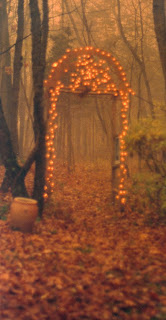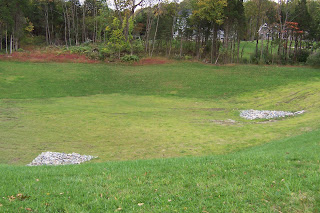Arbors: Style and Placement

This is Dan’s first arbor, an earlier version of the one pictured in the previous post. While I’m not crazy about the use of twinkle lights in the garden, here they lent an ethereal air to the forest and served a practical purpose, as well: A night light for the doggy relief area during those late nocturnal and early morning runs.
Choosing an arbor that is in harmony with the architectural style of the house and the landscape style of the garden, and siting it appropriately, are crucial to having it integrate well into its surroundings. While budget is an issue for many gardeners, as is not having a live-in arbor-artist, there are still many choices available ready made, or with only “some assembly required.”
Smooth, unfussy surfaces and sleek styling go well with contemporary, modern, or mid-century homes; ornate curlicues and botanical themes with cottages, farmhouses, and Victorians. Unpeeled logs or rough-sawn boards are good choices for a rustic look. If you are fortunate enough to own a period-style house, spend some time leafing through books or magazines on historic homes and gardens, or seek out Garden Conservancy Open Days tours to gather ideas.
One of the biggest mistakes I see in other people’s gardens is an arbor that serves no function and looks as if it were simply dropped into in the yard. The problem is most pronounced in new developments, where the homeowner may have been left with the minimum “builder’s landscaping” and the only alternatives are to either plant what one can afford and wait for everything to grow, or to spend a fortune to purchase and install mature specimens.
You can’t go too far wrong if you remember that arbors are meant to be doorways, either actual or implied. If you think of them as solid doors, you’ll realize that you would never just stick a door in the middle of the lawn. Arbors need to be attached to something; the house, the fence, a garage, an outbuilding; or have a suggestion of attachment; such as to trees on either side of a pathway, or the plants that cover them.

